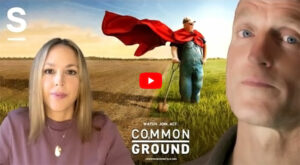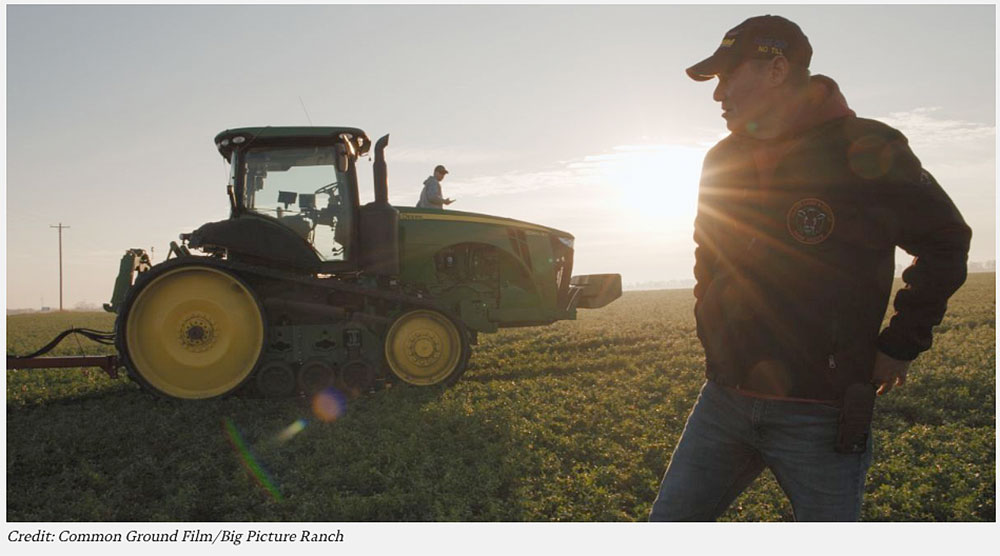Methane and deforestation from cattle ranching isn’t magically offset by “regenerative” agriculture.
The beef and dairy industries have successfully shoehorned their latest P.R. scheme for continuing the climate-heating cow business — so-called “regenerative ranching” — into “Common Ground,” a documentary about organic agriculture.

To quote the April, 2024 Sentient Media article below: “Unfortunately, that solution [regenerative ranching] is a vastly oversimplified one, and one that omits the importance of people eating less meat to combat climate change.”
 Methane and deforestation from farming cattle isn’t magically offset by regenerative agriculture. The new documentary, “Common Ground” mostly omits this truth.
Methane and deforestation from farming cattle isn’t magically offset by regenerative agriculture. The new documentary, “Common Ground” mostly omits this truth.
by Jessica Scott-Reid | April 22, 2024:
READ Sentient Media ARTICLE: https://sentientmedia.org/common-ground-cows-climate-change/
EXCERPTS:

Common Ground is the new documentary from the filmmakers of Kiss the Ground, the 2020 hit documentary that propelled regenerative agriculture into the mainstream… this followup film is now streaming on Netflix and is playing in over 75 theaters across the U.S. to coincide with Earth Day, on April 22 [2024].
Common Ground ultimately tells the same tale as the first film — that regenerative farming can save the planet — but this time with much more gusto, much more information and seemingly with much more at stake.
The first film was wildly successful. So much so that no matter how many times scientists and science writers demonstrated that regenerative agriculture does not actually “reverse climate change,” the practices were hailed as a solution, endorsed and funded by the U.S.D.A. as “climate-friendly” farming methods.
Unfortunately, that solution is a vastly oversimplified one, and one that omits the importance of people eating less meat to combat climate change.
Early in the film, when regenerative grazing is first mentioned, the audience is shown a side-by-side shot of bison and cattle. This idea that the two animals are one and the same is carried on throughout the film. “Regenerative agriculture aims to bring those bovines back,” recites Harrelson, grouping grass-fed cattle in the same category as wild ruminants who once naturally grazed the land.
But cows aren’t bison, and regenerative ranching isn’t “mimicking nature,” as the film states. Jennifer Molidor with the Center for Biological Diversity explains to Sentient that comparing the two species is like “comparing apples to oranges.”
Why cows ain’t like bison
The Sentient Media article doesn’t go into great detail about the differences between domesticated cows and wild bison, so below are listed just a few reasons why domesticated cows have wildly greater impact on the land:
1. Domesticated beef and dairy cows were brought to this continent about 200 years ago from Europe and since then their laboratory breeding and genetic manipulation by industry has expanded geometrically, and continues to this day — not to mimic bison in physiology or behavior, but to produce more yield, more meat and milk, for profit. Therefore…
2. Modern, gene-manipulated domesticated cows don’t move and eat (graze) the way wild bison do; they eat a lot more, they drink a lot more. Therefore…
3. Today’s commercial cows, unlike wild bison, are fed and watered supplementally. Some are fed a lot, some less for what the industry calls “finishing” cattle (before finishing them off with a bolt gun to the head and/or knife to the throat). But even so-called “grass-fed” and “free-range” cows don’t just live off the land like wild bison do or at least used to. This difference is especially significant in the dry, and increasingly drought-stricken western U.S. where cows consume massive amounts of precious, dwindling water supplies. In addition…
4. Cows produce far more manure than bison do; so much more that the massive amounts of feces and urine that beef and (larger) dairy cows excrete become a huge land and water pollution problem in and of themselves. One example: Point Reyes National Seashore where surface water tests have documented how commercial cow waste contaminates streams and other waterways, posing an active threat to the wild animals (and humans) who rely on clean water.
5. Bison hooves are shaped differently, evolved to break up the soil which aerates it, a benefit to wildlands which bison co-evolved with, over thousands of years. But cow hooves, larger and flatter, evolved for less movement, compact and thus desiccate soil, and trample plants. because they…
6. Cows, especially dairy cows — which are cows who are forcibly impregnating to become lactating mothers — weigh a lot more than bison, often 1,200 pounds or more. That’s because they are bred for human consumption and profit, not to benefit landscapes. Bigger cows mean bigger business profits, but bigger land abuse too. Because…
7. Cows are part of an extractive industry, not wild animals as part of a closed ecological loop. Cows are fattened on the land they compact and coat with manure and saturate with urine — even when “rotationally grazed,” meaning forced to move around. Ultimately, cows are then removed from the land, not left to die and decompose as wild bison do. Bison carcasses feed wolves, coyotes, vultures, insect larvae and ultimately even their bones return to the soil too.
8. “Rotationally grazed” cattle require even more land to occupy and damage than cows in CAFOs. Disgusting and filthy and unsanitary and antibiotics-dependent as concentrated cattle feed lots are, they actually do less ecological damage because there sewage is concentrated and localized, like the human sewage from a NYC apartment building.
Back again to Point Reyes National Seashore, home to what many consider ideal, “small,” “historic,” “local,” “sustainable” and “environmentally-friendly” dairies and beef ranches — which are all industry buzzwords without actual or legal definitions. At Point Reyes, a national part unit, on supposedly protected land, ranchers “get rid of” excess manure by literally spraying thousands of gallons of liquified manure right on top pasture lands. Yes, this practice is as smelly, filthy, harmful and disgusting as it sounds. But PLEASE don’t take my word for it. Instead…
Watch the cow shitty VIDEO short, “Cesspool by the Seashore:”
9. Methane emissions from cattle are always omitted from the “regenerative ranching” sales pitch. Lots of talk about carbon capture in the soil (as in Common Ground and Kiss the Ground), but little or no mention of methane, which is a wildly more potent heat-trapping atmospheric gas.
10. Even the supposed benefits of rotationally grazing cows to stimulate grass growth to “carbon capture” are bogus too, outweighed by the overall carbon losses of the cattle industry’s huge carbon hoofprint: transportation, feed production, and that granddaddy planet killer, deforestation.
Raising and feeding cattle for human consumption remains the #1 driver of global deforestation, the destruction of precious forests, those actual (not imaginary) carbon-capturing climate cooling superheroes.
READ MORE about regenerative ranching.
READ MORE about the massive negative environmental impacts of cattle ranching, which far outweigh any supposed benefits of moving cattle around more land, the latest cattle industry shell game called regenerative ranching.
READ Sentient Media ARTICLE: https://sentientmedia.org/common-ground-cows-climate-change/

